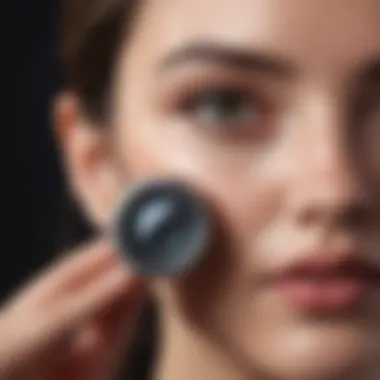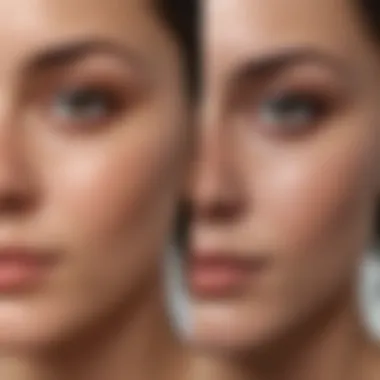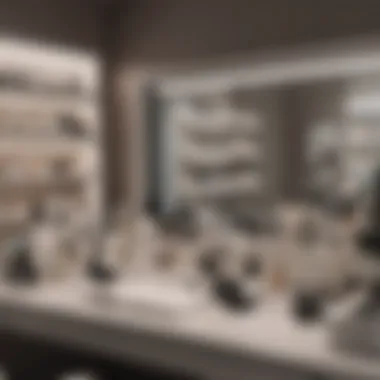Effective Home Methods for Blackhead Removal


Intro
Blackheads are a common skin concern for many individuals. They result from clogged pores that become filled with oil, dead skin cells, and bacteria. Unlike other forms of acne, blackheads are not inflamed, which makes them often perceived as less serious. However, they can still impact a person’s confidence and overall skin appearance.
In the search for clear skin, many people look toward various methods for blackhead removal. Fortunately, effective techniques exist for safely tackling this skin issue at home. This guide aims to provide a thorough examination of practical, at-home methods, including natural remedies, tools to use, and essential steps to incorporate into one's skincare regimen.
Understanding the underlying causes of blackheads, along with preventive measures, is also crucial. As you read through this article, you will learn not only how to remove blackheads but also how to maintain healthier skin overall.
"A proper skincare routine is essential not only for removing blackheads but for preventing their formation in the first place."
Now, let us delve into the trends and best practices in skincare that can aid in achieving clearer skin.
Understanding Blackheads
Understanding blackheads is essential to successfully remove them and maintain better skin health. Blackheads are a common skin concern that can affect anyone at any age. By knowing more about their formation, causes, and impacts, we can approach removal methods with more knowledge and caution.
Definition and Formation
Blackheads are a type of acne that occur when hair follicles become clogged with excess oil, dead skin cells, and bacteria. The surface of the clogged follicle opens and becomes exposed to air, leading to oxidation. This process results in a darkened appearance at the top of the pore.
The formation of blackheads typically happens in areas of the skin that have a higher concentration of sebaceous glands, such as the nose and forehead. An understanding of this process can inform more effective removal strategies and prevent future breakouts.
Common Causes
Excess Oil Production
Excess oil production is a primary contributor to the formation of blackheads. Sebaceous glands produce sebum, which is necessary for keeping skin hydrated. However, when there is an overproduction of oil, it can lead to clogged pores. This has a direct correlation with factors such as hormonal shifts, comedogenic products, and environmental conditions. Understanding oil production helps in selecting appropriate products for cleaner skin.
Dead Skin Cells
The accumulation of dead skin cells is another significant cause of blackheads. Skin naturally sheds dead cells, but sometimes this process can become irregular, leading to buildup in hair follicles. This buildup exacerbates the chances of pore blockages. It’s vital to have regular exfoliation in your routine to maintain even skin texture and prevent clogged pores.
Bacterial Growth
Bacterial growth plays a role in the aggravation of blackheads. The skin is home to various bacteria, including Propionibacterium acnes, which can thrive in clogged pores. When oil and dead skin cells combine with bacteria, inflammation can occur, resulting in acne breakouts. Recognizing this link emphasizes the importance of maintaining a clean face.
Hormonal Changes
Hormonal changes, often seen during adolescence, menstrual cycles, or conditions like polycystic ovary syndrome, can stimulate oil production in the skin. These fluctuations in hormones contribute significantly to acne. By understanding these hormonal impacts, one can adjust skincare routines or consult professionals for targeted treatments.
Impact on Skin Health
The presence of blackheads can negatively affect skin health. Clogged pores can lead to more severe forms of acne, including cysts and pustules. Additionally, the appearance of blackheads may lead to feelings of self-consciousness and affect overall confidence. An informed approach to blackhead removal can minimize these impacts, leading to healthier skin and a clearer complexion.
Preventive Measures
Preventive measures are an essential focus for maintaining clear skin and reducing the occurrence of blackheads. Understanding how to prevent their formation can save both time and resources spent on removal. This section examines specific elements that contribute to effective preventive strategies such as consistent skincare, dietary choices, and lifestyle adjustments. By integrating these measures into daily routines, individuals can help maintain healthier skin and minimize the reappearance of blackheads.
Consistent Skincare Routine
Consistency in skincare lays the foundation for healthy skin. Developing a regular regimen tailored to individual skin types is vital. Here’s a deeper look at its components:
Daily Cleansing
Daily cleansing is crucial in removing impurities, excess oil, and dead skin cells that can lead to blackheads. The key characteristic of this practice is the use of a gentle cleanser suited for one's skin type. It is important because it helps to keep pores clean and can prevent the development of blackheads.
Unique Feature: The effectiveness of daily cleansing lies in its straightforwardness and accessibility. By incorporating it into morning and evening routines, individuals give their skin a fighting chance against clogged pores. However, using harsh cleansers can strip the skin of natural oils, leading to dryness and irritation.
Exfoliation Frequency
Exfoliation involves the removal of dead skin cells from the surface of the skin. It supports the overall goal of minimizing blackheads by promoting cell turnover. The key characteristic here is the frequency of exfoliation; finding the right balance is crucial.
Unique Feature: Regular exfoliation can prevent pores from becoming blocked, but over-exfoliation may lead to irritation and breakouts. Generally, exfoliating 2-3 times a week is advised for most skin types, but adjustments may be necessary based on individual reactions.


Moisturizing Techniques
Moisturizing helps to hydrate the skin, contributing to its overall health. The key characteristic of effective moisturizing techniques is selecting products that do not clog pores. It is a beneficial practice because it balances skin moisture levels, promoting a softer appearance and preventing excessive oil production.
Unique Feature: Different skin types may require varying moisturizing products. For instance, gel-based moisturizers are often favored by oily skin, while creams are ideal for dry skin. The challenge is to choose the right product that aligns with individual needs while avoiding complications that could arise from incorrect applications.
Dietary Considerations
Diet plays a significant role in skin health. This section addresses dietary considerations as another preventive strategy against blackheads. Choosing the right foods can have a powerful impact on skin behavior.
Hydration
Drinking adequate water is vital for skin health. The key characteristic of hydration is its direct association with skin elasticity and detoxification. Proper hydration contributes extensively to reducing the appearance of blackheads.
Unique Feature: Hydration works from within, helping to flush out toxins and maintain skin's natural moisture balance. Dehydration, in contrast, can exacerbate skin issues, leading to increased oil production.
Antioxidant-Rich Foods
Incorporating antioxidant-rich foods, like blueberries and spinach, supports skin vitality. The key characteristic of these foods is their ability to neutralize free radicals, which can damage skin cells. Their role in preventing blackheads is linked to reducing inflammation and promoting healthy skin cell function.
Unique Feature: Foods rich in antioxidants often include vitamins C and E, which enhance skin repair and overall appearance. A diet lacking in these nutrients could lead to increased skin issues and definitely should be avoided.
Avoiding Processed Foods
Processed foods can negatively affect skin health. The key characteristic of this preventive measure is its focus on whole, natural ingredients. By avoiding processed foods, individuals may help reduce inflammation, which often leads to clogged pores.
Unique Feature: Many processed foods are high in sugars and unhealthy fats, contributing to skin problems. A balanced diet focusing on whole foods can be more beneficial for avoiding blackheads.
Lifestyle Choices
Adapting certain lifestyle choices can complement a skincare routine and dietary habits. This segment highlights how particular lifestyle practices can enhance skin health and prevent blackheads effectively.
Stress Management
Stress has a significant impact on skin health. The key characteristic of stress management is its ability to balance hormones, which in turn affects oil production. Reducing stress can lead to fewer breakouts, including blackheads.
Unique Feature: Engaging in regular stress-reducing activities such as yoga, meditation, or exercise can promote overall health and improve skin condition.
Sleep Hygiene
Adequate sleep is necessary for skin repair and renewal. The key characteristic of sleep hygiene involves maintaining a consistent sleep schedule. Good sleep contributes to better skin health and aids in mitigating the development of blackheads.
Unique Feature: Poor sleep patterns can cause hormonal fluctuations that lead to increased oil production, thus exacerbating skin issues. Maintaining a regular sleep routine can counter this.
Limiting Makeup Use
Restricting the use of makeup, especially heavy products, can significantly benefit skin health. The key characteristic here is the emphasis on breathability for the skin. Limiting makeup allows the skin to regenerate and reduces the chances of pore blockage.
Unique Feature: Choosing non-comedogenic makeup options is essential for individuals prone to blackheads. Frequent use of heavy products can contribute to acne, so moderation is crucial.
Keeping a disciplined skincare routine alongside proper dietary and lifestyle choices creates a multifaceted approach to preventing blackheads, ultimately leading to clearer and healthier skin.
Home Remedies for Blackhead Removal
Home remedies for blackhead removal have gained recognition as effective and affordable solutions for individuals looking to improve their skin clarity. These methods utilize common household ingredients to address blackhead issues without the need for expensive treatments or procedures. The benefits are numerous; they often include reduced risk of irritation, lower costs, and a more natural approach to skin care. This section will detail several remedies that have shown effectiveness and can be easily integrated into a skincare routine.
Natural Exfoliants
Natural exfoliants are vital for removing dead skin cells from the surface of the skin. They help clear pores and reduce the occurrence of blackheads. Here are some popular natural exfoliants that can be used at home:
Baking Soda Scrub
Baking soda serves as a gentle exfoliant that can unclog pores. Its key characteristic lies in its slightly abrasive texture, which works to slough away dead skin cells. Many consider it a beneficial option because it is readily available in most kitchens. However, baking soda also has a pH level that can disrupt the natural acidity of the skin, so moderation is essential. Using it too often may lead to dryness or irritation. When used sparingly, baking soda can contribute positively to blackhead removal.
Coffee Grounds


Coffee grounds provide a dual benefit: they exfoliate and also energize the skin. Their coarse texture makes them effective at removing impurities and dead skin. This ingredient is popular because of the caffeine content, which can improve circulation and give the skin a vibrant appearance. A consideration is that, like baking soda, they can irritate sensitive skin if used too aggressively. A gentle approach, mixing with a bit of oil or yogurt, can create a balanced scrub that minimizes risks.
Oatmeal
Oatmeal is known for its calming properties. It acts as a natural exfoliant while being gentle on the skin. Rich in antioxidants, oatmeal can also help reduce redness and inflammation caused by blackheads. Its absorbent nature allows it to soak up excess oil, aiding in the prevention of further breakouts. One point to note is that people with gluten allergies should seek gluten-free oatmeal. Overall, oatmeal offers a soothing alternative that nourishes while combating blackheads effectively.
Cleansing Masks
Cleansing masks play an essential role in blackhead removal, as they draw out impurities and excess oil from the skin. The following masks utilize natural ingredients that can yield beneficial results:
Clay Masks
Clay masks are renowned for their oil-absorbing properties. They penetrate the skin, helping to draw out toxins and unclog pores. Their unique feature is their variety; options like bentonite or kaolin clay can cater to different skin types. Many find these masks beneficial because they can leave the skin feeling refreshed and clear. However, overuse can lead to excessive drying, which makes hydration critical after their application.
Honey and Cinnamon
This combination is not only delicious but also effective for skincare. Honey is naturally antibacterial, which helps fight the bacteria contributing to acne, while cinnamon enhances circulation. This mask can help reduce inflammation and provides a soothing effect. Still, it is important to perform a patch test, as some individuals may experience allergic reactions to cinnamon. If tolerated, this mixture serves as a beneficial remedy, promoting clearer skin.
Activated Charcoal
Activated charcoal has gained popularity for its ability to absorb impurities and toxins from the skin. Its primary characteristic is its high adsorption capability, making it a popular choice for deep cleansing. Many enthusiasts appreciate how effective it is at unclogging pores as well. One downside is that it may leave skin feeling dry, so following up with a good moisturizer is essential to maintain skin balance after use.
Steam Treatments
Steam treatments can be an effective way to loosen blackheads and open up the pores. This method allows the skin to absorb moisture and can enhance the overall effectiveness of subsequent cleansing methods. Regular steam treatments can help improve circulation as well, making the skin look more vibrant. However, those with sensitive skin or specific conditions should approach steaming with caution, as it could cause irritation if done excessively. It's key to keep treatment sessions moderate and to use proper post-treatment skincare following the steam therapy.
Tools for Blackhead Removal
The use of proper tools for blackhead removal is crucial for achieving clearer skin. Various instruments can aid in the process, making it more effective and safer. These tools can minimize the risk of irritation or scarring that may occur through improper extraction techniques. Understanding the different tools available helps individuals select the right options for their specific skincare needs.
Extraction Tools
Extraction tools are designed to help remove blackheads without damaging the skin. They come in various forms, and they can facilitate a more controlled and precise removal process.
Comedone Extractors
Comedone extractors are popular for their effectiveness in removing blackheads. One key characteristic of these tools is their double-ended design, which offers different loop sizes for various pore sizes. This versatility makes them a beneficial choice in the context of blackhead removal.
A unique feature of comedone extractors is their ability to apply even pressure around the blackhead, minimizing discomfort. However, if not used correctly, they can lead to skin bruising or irritation. Following proper techniques is essential for achieving good results while avoiding potential drawbacks.
How to Use Them Safely
Understanding how to use comedone extractors safely is vital for optimal results. A specific aspect here is the importance of sanitizing the tool before use. This prevents bacterial growth, which could lead to further skin issues. This practice is crucial in the context of blackhead removal, as it helps maintain skin health post-extraction.
Another key characteristic is the need for gentle pressure during the extraction. Using excessive force can lead to skin damage, which undermines the goal of clearer skin. Following proper usage guidelines can ensure that this tool is both effective and safe.
Pore Strips
Pore strips are another accessible option for blackhead removal. They function by adhering to the skin and extracting debris from pores upon removal. This method is popular among individuals looking for quick results with minimal equipment.
Types of Pore Strips
There are various types of pore strips available, and each serves its unique purpose. For instance, some strips are designed specifically for the nose, while others can be applied to different areas of the face. This categorization is an advantage, as it allows users to choose according to their needs.
Another unique feature of pore strips is their formulation. Some may include ingredients that help in oil control or exfoliation. However, users should be cautious as frequent use on sensitive skin can lead to irritation.
Application Tips
Applying pore strips correctly is essential for effective results. A specific aspect to consider is cleansing the face before application. This ensures that the strip adheres properly and can pull out maximum impurities. This step is vital for enhancing the effectiveness of the product.
The timing for strip removal is also crucial. Leaving the strip on for too long can cause skin irritation, while removing it too soon may not yield the desired results. With careful attention to these tips, users can optimize their experience with pore strips.
Facial Brushes


Facial brushes enhance daily skincare routines, offering deeper cleansing and exfoliation. They can effectively contribute to blackhead prevention. Choosing the right brush is critical for maximizing these benefits.
Benefits of Using a Brush
One of the main benefits of using a facial brush is its ability to provide a more thorough cleanse compared to just using hands. This effectiveness makes it a popular addition to many skincare regimens. With regular use, a facial brush can help to reduce excess oil and prevent blackheads over time.
A unique feature of these brushes is that they come in various textures and bristle types, allowing for personalized use. Nonetheless, it’s essential to select a brush that suits your skin type to avoid any irritation or discomfort.
Choosing the Right Brush
Selecting the right facial brush involves considering several factors. The bristle hardness is a critical aspect, especially for those with sensitive skin. A brush with soft bristles is often recommended to avoid excessive irritation while still providing cleansing benefits. This choice is beneficial for all skin types seeking to maintain a healthy complexion.
Another important characteristic is the brush's design. Some may offer vibrations or rotations to aid in exfoliation. While these features can enhance results, they may not be suitable for every skin type. Assessing skin sensitivity and personal preference is key to making the best choice.
Post-Removal Skincare
Post-removal skincare is vital for achieving clear and healthy skin after blackhead extraction. When blackheads are removed, the skin may become sensitive or vulnerable to irritation. Proper aftercare helps maintain skin balance and supports healing. Several elements of post-removal skincare should be emphasized to ensure the skin recovers well and looks its best.
Soothing Treatments
Soothing treatments play a crucial role in calming skin after blackhead removal. Ingredients like aloe vera, chamomile, and witch hazel can reduce redness and provide relief. Aloe vera is well known for its soothing properties, helping to cool the skin and minimize irritation. Chamomile can also aid in reducing inflammation, promoting a sense of comfort post-procedure. Likewise, witch hazel is effective due to its astringent quality, closing the pores after extraction. These treatments should be applied gently and consistently to foster skin recovery.
Hydration Strategies
Hydration strategies are essential in post-removal care. It’s important to replenish moisture to avoid dryness. A good moisturizer with ingredients like hyaluronic acid can help draw moisture into the skin, keeping it supple. Lightweight formulas are preferable as they won't clog pores. Hydrating serums can also be beneficial, applied on damp skin for maximum absorption. Remember to drink plenty of water as internal hydration is just as important as topical application.
Avoiding Irritation
Products to Avoid
Certain products should be avoided in post-removal skincare to prevent irritation. Harsh scrubs, alcohol-based toners, and strong active ingredients like retinoids can exacerbate sensitivity. The key characteristic of these products is their potential to disrupt the skin barrier after extraction. Avoiding them helps ensure a positive healing environment. Choosing gentler alternatives, such as fragrance-free and hydrating formulations, will be more beneficial.
Signs of Irritation
Recognizing the signs of irritation is crucial in post-removal care. Common symptoms include redness, itching, and a burning sensation. These indicators highlight that the skin may not be reacting well to the current routine or products. Early recognition allows for timely adjustments. This characteristic contributes to the goal of maintaining skin health by addressing issues before they escalate. Keeping an eye on the skin can guide individuals in making necessary changes or consulting professionals when needed.
"Post-removal skincare sets the foundation for long-term skin health. Proper hydrating and soothing treatment can noticeably improve the skin's appearance and feel."
When to Seek Professional Help
Knowing when to seek professional help for blackhead removal is crucial for your skin health. Many people can manage minor cases of blackheads and maintain a good skincare routine at home. However, there are situations where home remedies and tools are not sufficient. Understanding these thresholds can prevent further skin damage and help you maintain better skin health.
Signs of Severe Acne
One of the clear indicators that you may need professional assistance is the presence of severe acne. Here are some signs that suggest it’s time to consult a dermatologist:
- Inflammation: If blackheads are accompanied by redness and swelling, it is a sign of inflammation.
- Pus-filled cysts: When blackheads turn into painful bumps filled with pus, it's time to consider professional help.
- Persistent breakouts: If you find that new blackheads and pimples keep appearing, despite your efforts to remove them, professional treatment may be necessary.
- Large pores: Enlarged pores are often associated with ongoing acne issues. A dermatologist can offer targeted treatments to minimize their appearance.
- Pain or discomfort: Experiencing significant pain or discomfort around blackheads is another strong sign to seek help.
These signs indicate that your skin may require a more advanced treatment than what over-the-counter solutions can provide. Getting specialized care can prevent further complications and improve your skin condition.
Consulting a Dermatologist
When you decide to consult a dermatologist, you gain access to professional insights and treatment plans tailored to your needs. A dermatologist can diagnose your skin type and suggest effective solutions. They may recommend a variety of treatments:
- Topical treatments such as retinoids, which can help unclog pores and reduce blackhead occurrence.
- Chemical peels that exfoliate the skin, removing dead skin cells and promoting cell turnover.
- Extractions performed in a sterile environment to minimize the risk of scarring and infection.
- Laser therapy for targeted treatment can also be effective for persistent blackheads.
Scheduling an appointment for your skin concerns is a step toward better skin health. Understanding when to ask for help can greatly improve outcomes. Be proactive about your skin's health and seek expertise when necessary.
Culmination
By integrating proper techniques and tools, the risk of skin irritation and scarring is greatly reduced. Individuals should remember that adhering to a personalized routine not only enhances skin health but also instills confidence. Blackhead management is not merely about aesthetics; it also involves making informed choices that benefit skin wellbeing in the long term.
Recap of Key Points
- Blackheads form due to excess oil, dead skin cells, and bacteria within pores.
- A strong skincare routine is essential for prevention and removal.
- Home remedies like baking soda scrubs and clay masks can be effective.
- Using tools such as comedone extractors requires caution.
- Post-removal care is crucial to prevent irritation and promote healing.
- Seek professional help if experiencing severe acne symptoms.
Encouraging A Consistent Routine
Establishing a consistent skincare routine is vital for maintaining skin clarity. Following a structured regimen that includes daily cleansing, exfoliation, and moisturizing can lead to long-term benefits. Each step plays a role in preventing the buildup that causes blackheads.
Furthermore, building habits such as staying hydrated, eating antioxidant-rich foods, and managing stress contributes positively to overall skin health. It is important to adjust your routine based on skin type and environmental factors. By prioritizing skincare, individuals can achieve clearer skin and reduce the likelihood of frequent blackhead occurrences.
Ultimately, awareness and dedication to a consistent skincare routine not only help combat blackheads but also enhance one’s skin condition over time.















